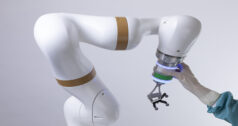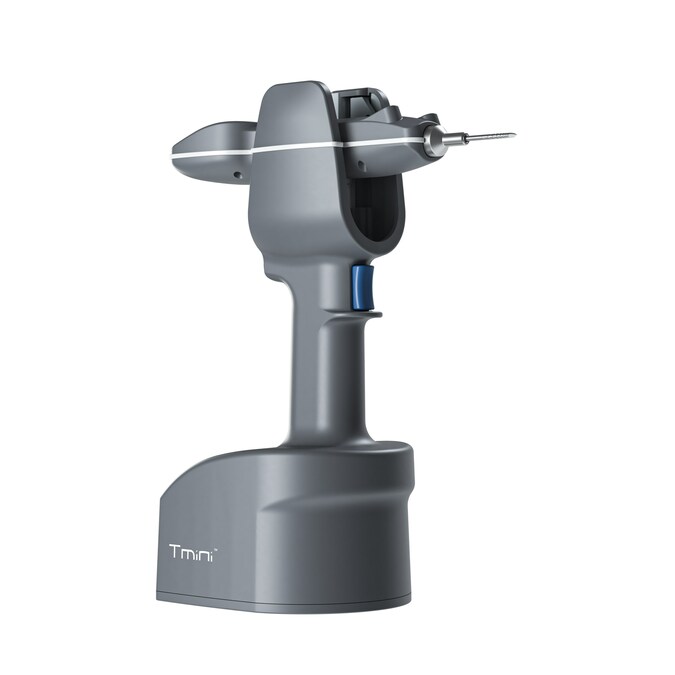
Orthopedic robots facilitate accurate implant placement and personalized patient care. They have the potential to minimize tissue damage, blood loss and complication risks. They’re the centerpiece of the movement toward digitally enabled surgery and the constant search for surgical innovation.
Orthopedic companies are taking notice and pushing the envelope to advance robotic platforms past their current capabilities.
“Today’s systems have room for improvement in clinical workflow flexibility, O.R. integration, patient-matched implant selection and joint kinematics planning,” said Joel Zuhars, Vice President of R&D at THINK Surgical. “They need to be faster to set up and easier to operate.”
He added that advancements in near-field camera technology, device miniaturization, adaptive software algorithms and deep learning techniques for the optimization of surgical planning — including intraoperative plan adjustments — will enhance future robot capabilities in clinically relevant ways.
The overarching goal, according to Zuhars, is to drive efficiency, reduce the physical and cognitive burden on surgeons and O.R. staff and — most importantly — ensure improved and consistent patient outcomes.
Companies also seek to create synergy across specialties, which involves integrating various components seamlessly within a digital ecosystem to enhance overall surgical efficiencies. These efforts involve tackling challenges like incorporating various robotic-enabled instruments into a single platform, addressing limitations in flexibility of technique or procedural workflow and accommodating surgeon preference, according to Keith Evans, Vice President and General Manager of Stryker’s Spine Division, Enabling Technologies.
“We want to continue to meet our customers where they are,” he said. “But we also need to focus on future improvements that will move robotic surgery forward in meaningful ways.”
Artificial Intelligence Advances
In the quest for superior surgical outcomes, the integration of artificial intelligence (AI) and machine learning emerges as a pivotal frontier. Zuhars acknowledged the early stage of AI applications, but noted that the technology’s potential lies in its ability to integrate vast amounts of data to enhance surgical precision and decision-making. As AI matures, it holds the promise to revolutionize orthopedic robotics with nuanced insights and an ability to adapt to individual patient needs.
“Research is ongoing into how AI can improve surgical planning, but this work is in the early stages and there are significant regulatory hurdles to overcome,” Zuhars said. “The detection and consideration of different types of anatomy, along with the disease state and lifestyle goals of the patient, seem to be important elements to consider in this regard.”
Laurence Chabanas, Chief Strategy Officer at eCential Robotics, noted that sensors and smart interactive user interface technologies provide surgeons with more information and awareness about their intraoperative movements. She envisions a future in which AI and machine learning create a comprehensive feedback loop that spans the pre-, intra- and postoperative phases. This integration could provide decision-assistance tools at each step, ensuring a continuum of care that maximizes patient outcomes.
“The next generation of robots will need to develop new surgical capabilities but also be fully integrated within the healthcare ecosystem,” Chabanas said. “They must be able to receive, analyze, collect and transmit large amounts of data. This complexifies the engineering architecture and components of the devices, which must possess increased computing power.”


THINK Surgical’s TMINI Miniature Robotic handpiece, developed in partnership with Sagentia Innovation.
Compact and Versatile
The landscape of orthopedic surgeries is evolving, with an increasing number of cases shifting to ASCs. Companies are therefore designing the latest robotic platforms with a focus on ensuring that the systems are versatile and easily deployable.
“We’ve been working to optimize the ease of use of new robotic platforms,” Chabanas said. “Too often, they’re complex to use and require additional staff members — and therefore increased costs — to operate. Simplifying the setup and improving the ease of use will allow more facilities to run robots with their current resources. That’s been a major point of emphasis for us.”
As increasing numbers of surgeries move to space-conscious ASCs, the need for compact and adaptable robotic platforms becomes paramount. The shift toward more streamlined designs aligns with efforts to make these advanced technologies accessible to a broader range of surgical facilities and, consequently, a more diverse patient population. As companies like Stryker develop the next generation of orthopedic robotic technology, one of their primary goals is to increase the utility across multiple specialties.
“How can we take these major capital investments that facilities are making and allow surgeons and their staff to use them easily and seamlessly in various procedures?” Evans asked. “We believe this versatility will help facilities get the most out of robotic technology and increase its access to a broader range of patient populations.”
Stryker’s objective is to ensure that the components of a robotic system can stand alone when appropriate, but also create synergy when they’re used within the company’s ecosystem.
“The primary goals will always be improved and consistent patient outcomes, driving efficiency and reducing the physical and cognitive burden on surgeons and surgical staffs,” Evans said.
“Open” concept robots have the potential to disrupt the joint replacement market. Breaking free from the conventional one-robot-per-implant-manufacturer model will allow platforms to offer more flexibility to surgeons and facilities. The ability to use any implant brand with any robot system increases options for surgeons and addresses cost concerns.
“Robotic platforms that are designed to work only with proprietary implants force surgical facilities to buy multiple robots that essentially have the same capabilities,” Chabanas said. “We’re offering an implant-agnostic platform that allows surgeons to use any implant systems with our enabling technologies.”
She stresses the importance of simplicity in the use of these technologies. The complexity often associated with advanced robotics can be a barrier to accessibility. Simplifying setup and usage is a strategic focus at eCential Robotics, which is working to ensure that medical facilities can operate these technologies seamlessly with their existing resources.


Stryker’s Q System allows surgeons to place screws virtually based on the patient’s actual spine anatomy.
Patient-centric Care
While tailoring surgical plans to individual patients isn’t a new concept, the ability to execute that plan precisely is where robotics “really shines,” according to Zuhars.
“Robots are capable of improving the accuracy and precision of bone cuts, both positionally and dimensionally,” he said. “Without these elements, the delivered procedure only approximates the planned procedure, which could potentially reduce the effectiveness of individualized care. So robotics, by its very nature, accommodates personalized surgical plans.”
Evans noted that Stryker is focused on placing the right enabling technology components in the O.R. to provide obvious benefits to surgeons and surgical staff. With those goals in mind, Stryker is creating surgical plans personalized with its Blueprint digital platform for upper extremity surgery.
Blueprint helps surgeons better understand glenoid, humeral and soft tissue deformities in patients undergoing shoulder replacement surgery. Surgeons can anticipate challenges and evaluate the range of implant types that could optimize outcomes before they step into the O.R.
Stryker’s Q Guidance System features Smart Segmentation capabilities that provide surgeons with suggestions for which screw type would be best to use in patients undergoing spine surgery. Surgeons select the vertebrae to be operated on and the system’s software automatically recommends a screw size and position based on anatomical metrics.
“We look forward to further streamlining these solutions and adding new capabilities over the next few years,” Evans said.
Chabanas noted that robotics continues to evolve to accommodate the latest surgical techniques. She said that the eCential robotic system is tailored to help surgeons treat patient-specific anatomy. For example, the system’s articulation axis and arm reach are fundamental components that allow surgeons to execute personalized surgical plans.
“On of top that, surgeons can choose the order of screw insertion, making the robot versatile for individual patient anatomy and surgeon preferences,” she added. “The robot can regulate the force needed to insert screws based on bone quality, which reduces the risk of skiving.”
The Next Frontier
Robotics is expanding into uncharted territory. Convergence Medical’s V01 system, the world’s first surgical robot designed for arthroscopic surgery, features three arms with 21 degrees of freedom, 2D and 3D video and instruments with flexible tips that work around corners in the surgical field.
V01 is placed alongside the patient during surgery, and single-use instruments are attached to the robot’s arms. Available power tools include shavers and burrs and general instrumentation such as graspers and scissors. Additionally, the robot incorporates arthroscopic stitch devices, probes and controlled ablation, along with vision channels to ensure optimal visibility. The suite of tools is designed for ease of use for the benefit of surgeons and O.R. staff.
About 70% of arthroscopic surgeons regularly experience significant musculoskeletal pain, which forces 30% of the surgeon workforce to retire early, according to Convergence CEO Chris Jeffery, MBBS. He said that V01 was developed to improve the ergonomics of arthroscopic surgery by providing surgeons with rigid stability and robotic precision in the surgical field, and to make surgery simpler and more efficient.
The Australia-based team of doctors and engineers at Convergence Medical have their sights set on disrupting the sports medicine market.
“We exist to address the significant problems in arthroscopic surgery, improving the lives of the 50 million patients treated every year and the 30,000 surgeons who perform these operations,” Dr. Jeffery said.
Increasing Access
Companies aren’t just looking at ways to make robotics more innovative and tech-driven — they’re also aware of how affordability impacts adoption rates.
“Cost-effectiveness is a bit of a chicken and egg problem in that significant adoption and cost are interdependent,” Zuhars said. “We’re currently in a high-cost and relatively low adoption rate environment. We believe that miniaturization of the robot into a handheld form factor and allowing surgeons the freedom to use the implants of their choice will reduce the direct and indirect costs of ownership to a level that will enable significant adoption of robotic technology. That, in turn, will further reduce the cost of the technology.”
Companies are also looking toward collaboration to boost their robot’s capabilities.
“Stryker has made significant investments in enterprise-wide data sharing,” Evans said. “Our Digital, Robotics and Enabling Technologies (DRE) organization is a great example of these efforts. Stryker created the team to attract talented engineers who want to work on product design and improve patient care.
“The DRE organization has allowed us to centralize and utilize R&D resources and assets more effectively,” Evans continued. “I think we’ll see the positive effects of this collaboration continue to come to life in a very exciting way over the next few years.”
It’s evident that the top thinkers in orthopedics are teaming up to move robotic-assisted surgery into its exciting next phase.
“We’re evolving into a very innovative and fast-changing environment,” Chabanas said. “Partnerships and collaborations are at the heart of our strategy.”
KK
Kendal Kloiber is a contributing editor.




